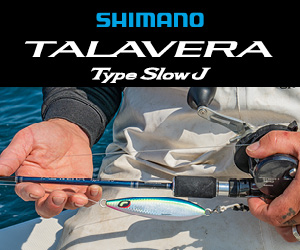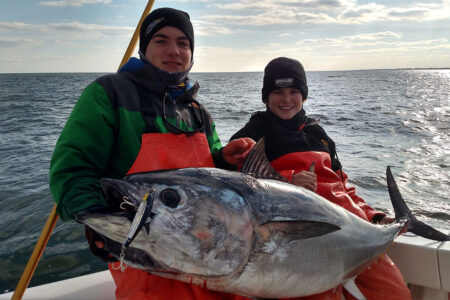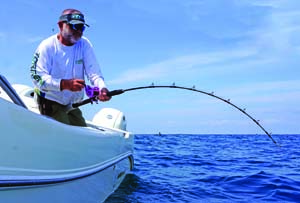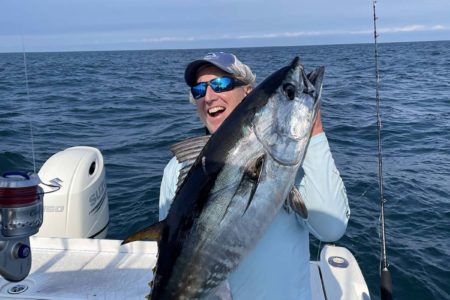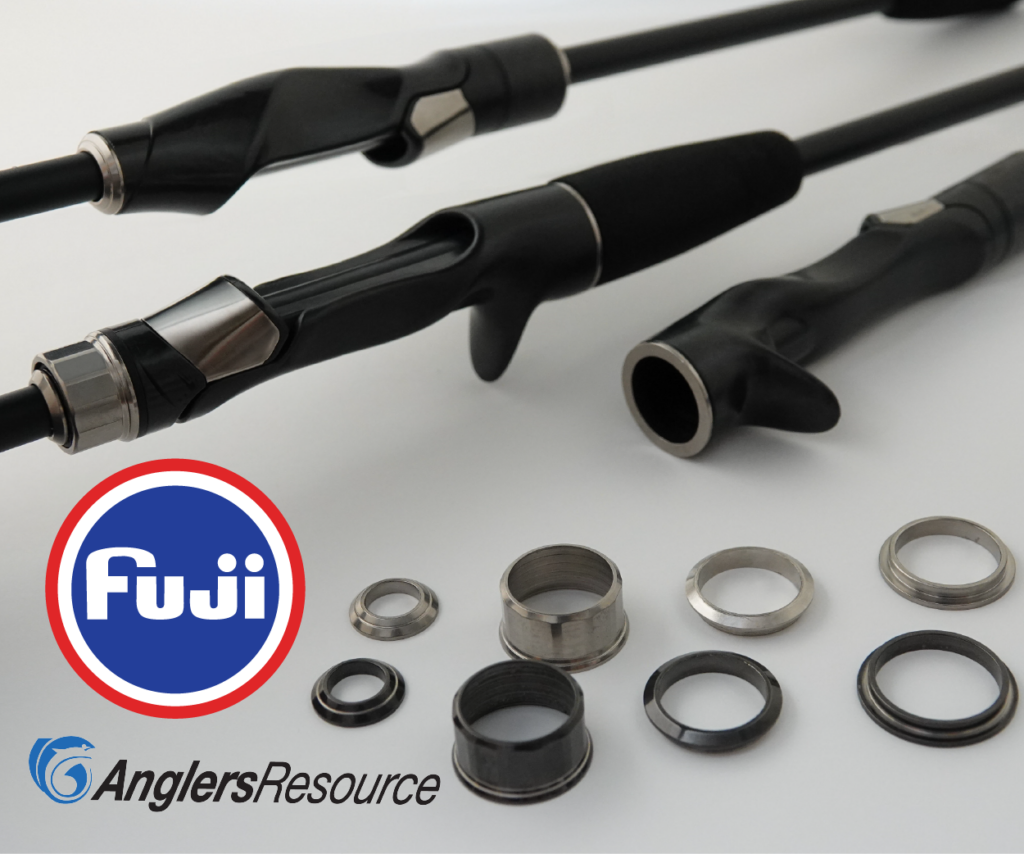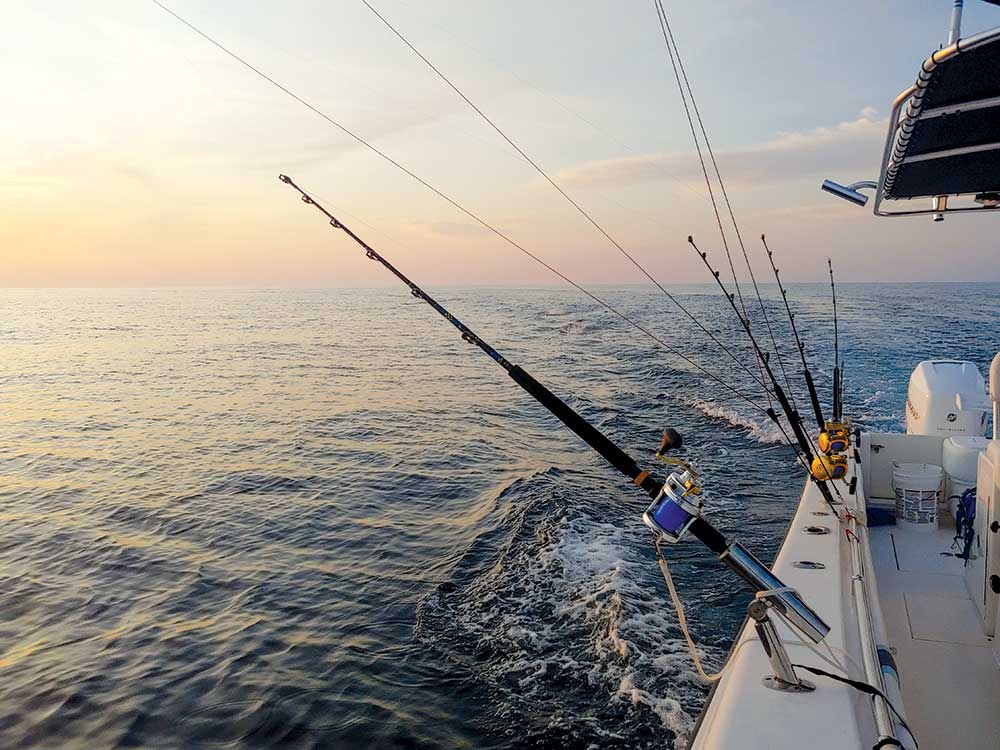
Bluefin action was off the charts in 2019, especially for those who had these specialty bars off the sides!
Wide or side trackers have been the latest and greatest new addition to trolling spreads; so much so that tackle shops in the region have had trouble keeping them on shelves. They work on all tuna, blue and white marlin, mahi-mahi, sharks, stripers, and just about anything anglers troll for. And just as quickly as shops receive new stock, a good portion may already be spoken for, the rest gobbled up soon after.
The wide tracker evolved from a compilation of side planer boards and spreader bars. Many iterations have come and gone with two main renditions standing the test of time. The first is a fixed rudder simple configuration, which is easy to deploy and works well. The fixed-wing bars by Sterling for example have port and starboard denoted on either side to remind anglers which way to deploy. The second style produced by the folks at Chatter as an example are adjustable, non-fixed wings allowing the angler to decide which side to run the bar on.
Function & Deployment
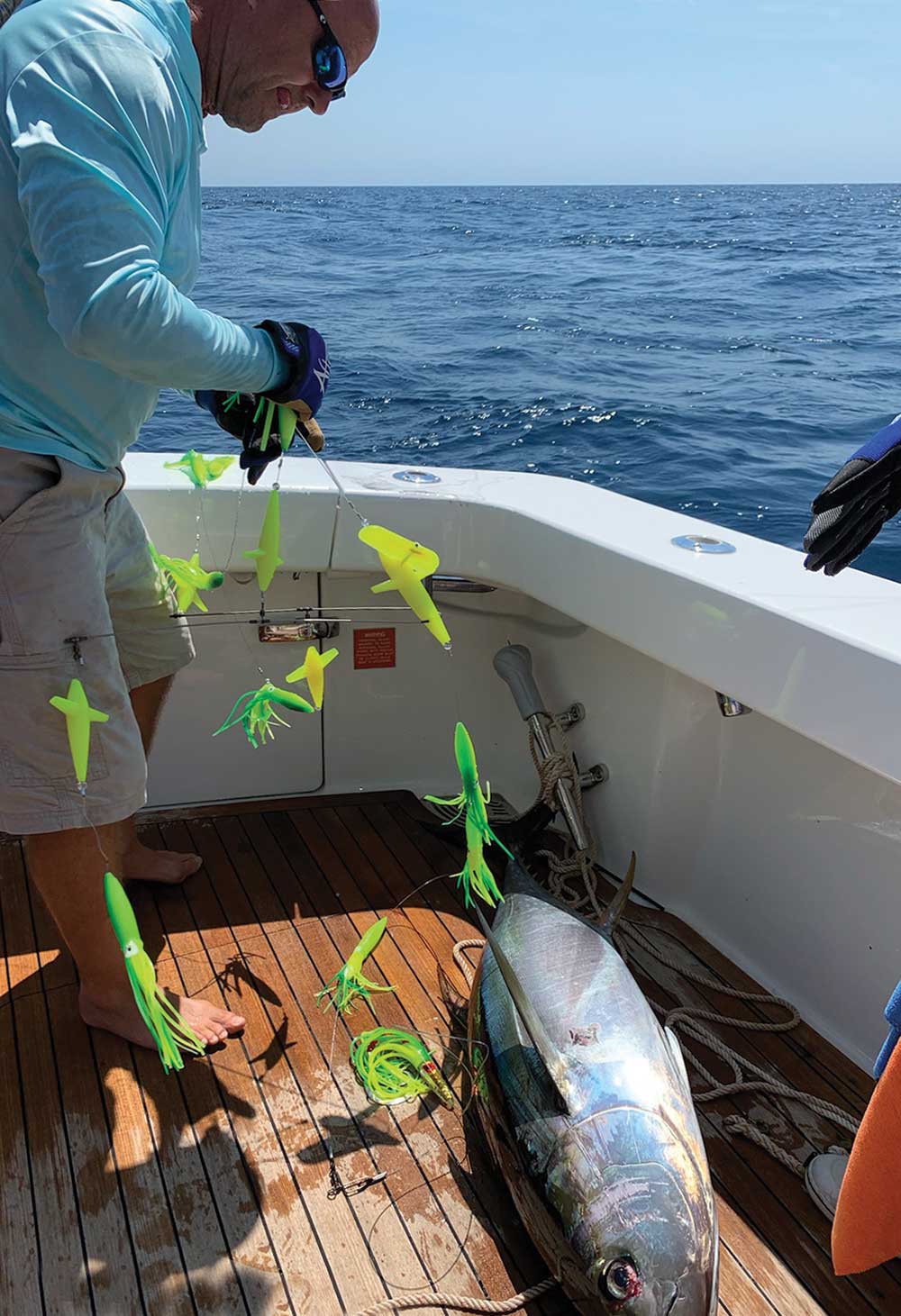
These wide tracking bars are, for the most part, small or large bird bars with a side planer blade located in the middle. When trolled the water pressure will pull the entire set up outboard. They go wider and can stay closer to the boat than traditional bars trolled from outriggers. This gets them in nice clean water and away from the prop wash. They are trolled like traditional spreader bars. Use bulb squid float bars on calmer days, and heavier machine head options on windy and ruff days. They can be trolled from an outrigger to get them even further out to the side.
There are a few theories on why they work so well, the first being that these swim in clear non-wake or turbulent water. Not only is it a cleaner presentation, but it adds a dimension to the spread. They are easily spotted, and the splashing of the chatter birds are clearer and more distinct. Fish also get used to seeing the same spread repeatedly. They learn that this pattern may be dangerous and become reluctant to feed on it. When you add side trackers the trolling spread’s appearance changes to something new that stands out from the fleet. They draw fish in from the sides. So, when you hook up (and you will) keep trolling as other school fish will be close by and usually will follow.
When hooked up the fish has two potential pressure points, the primary being the rod, and the second the bar. When the fish takes the bar down, it will fight the drag of the bar. The added drag of the submerged birds will help tire out and slow down a running fish. The line makes what resembles a checkmark. The fish feels this pressure and it will pull hard in the other direction, which can confuse the angler. As always, if you suddenly don’t feel pressure wind like crazy. The fish may be pulling the bar towards you (still fighting the bar) creating a loop. Get this slack in fast and stay tight.
You may be able to keep a smaller fish straight inline. In fact, when you are hooked into football-sized tuna, if the bar stays submerged for the entire fight you may be disappointed with how small the fish you caught is when boat side, a 25-pound yellowfin often feeling like it’s 75 pounds or more. If you are confident it’s a smaller fish, palm the spool and keep the boat in gear. This will plane the fish to the surface and pop the birds out, making it easier to reel in. You may pull the fish off too, which will allow you to get the bar back in the spread and continue trolling for larger fish.
Rigging & Maintenance
A great deal of backpressure is put on these bars when fighting a fish. They were designed to attract fish with surface action and placement, so when these birds are dragged backward underwater a great deal of pressure is added. Submerged bars can and will spin, which means the wing lines can tangle around the mainline. This can cause everything to ball up. Special attention to inspecting and correcting the bar after catching a fish is a must. Do not just untangle and drop it back in. The mainline should be scrutinized for nicks and chafing. If at all compromised take it out of service.
Some bars come with swivels that allow you to easily change the stinger or hook bait. If it’s the only thing producing, you do have options. You can take the stinger off and fish it as a teaser. Use your outrigger to get rigged ballyhoo behind and as close to it as possible. The other option is if you have the multi-directional version simply switch over to the desired side and you’re back in action. My trolling pattern is always deployed in pairs. For instance, if the port bar is getting all the bites while trolling in a specific direction, I can switch the starboard bar to port (on a multi-directional bar) and I am back in business. I can then add a different color or no side tracker at all to the weak side. The nice thing is to have options.
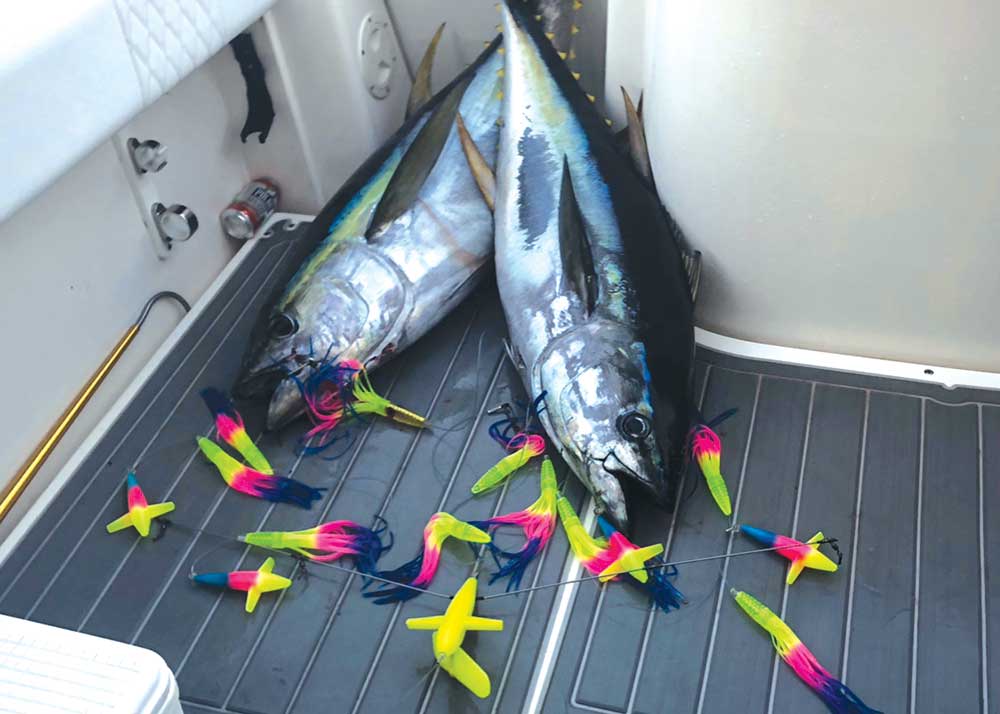
Pay attention to details. For fixed birds make sure to set them out top side up. For the multi-directional bird make sure the blade is locked in the desired position and the locking arm is in. Be cognizant of the blade orientation. It is easy to completely spin the blade 180 degrees. It looks more streamlined, but this is not the way they are designed to run. The blade needs to stick out in front of the bird to prevent the nose from digging in. You can use a sharpie to color the back of the blade to help remind you of the proper orientation. The bottom line is if they are not trolling wide or acting funny, the blade is either backward, or the stinger is fouled with weed. Also, watch the lures running next to them. Wind and boat speed can dramatically change how these bars track, so, keep an eye on them as you turn. If the bar digs in it can easily tangle with other lines.
On center console boats troll the bars off the front rodholders ahead of the helm. This allows you to keep an eye on the rods, while leaving your outriggers open for other offerings. When you hook up ensure that the line doesn’t rub any rods or lines behind it. A quick turn to the side that you hooked up on is usually enough to prevent this. If not, you may need to walk it to the back before clearing the other rods.
Shop Around
If you paid attention to weekly fishing reports throughout the region in 2019, all you heard was fish caught on “Sterling Wide Trackers,” or “Chatter Side Trackers did the trick,” or “Joe Shute’s ballyhoo.” Because of their individual success, adding ballyhoo to these side trackers became very popular. Combining both lures turned into a deadly option. In fact, Ron Z 10-inch tails were also substituted for ballyhoo with tremendous success.
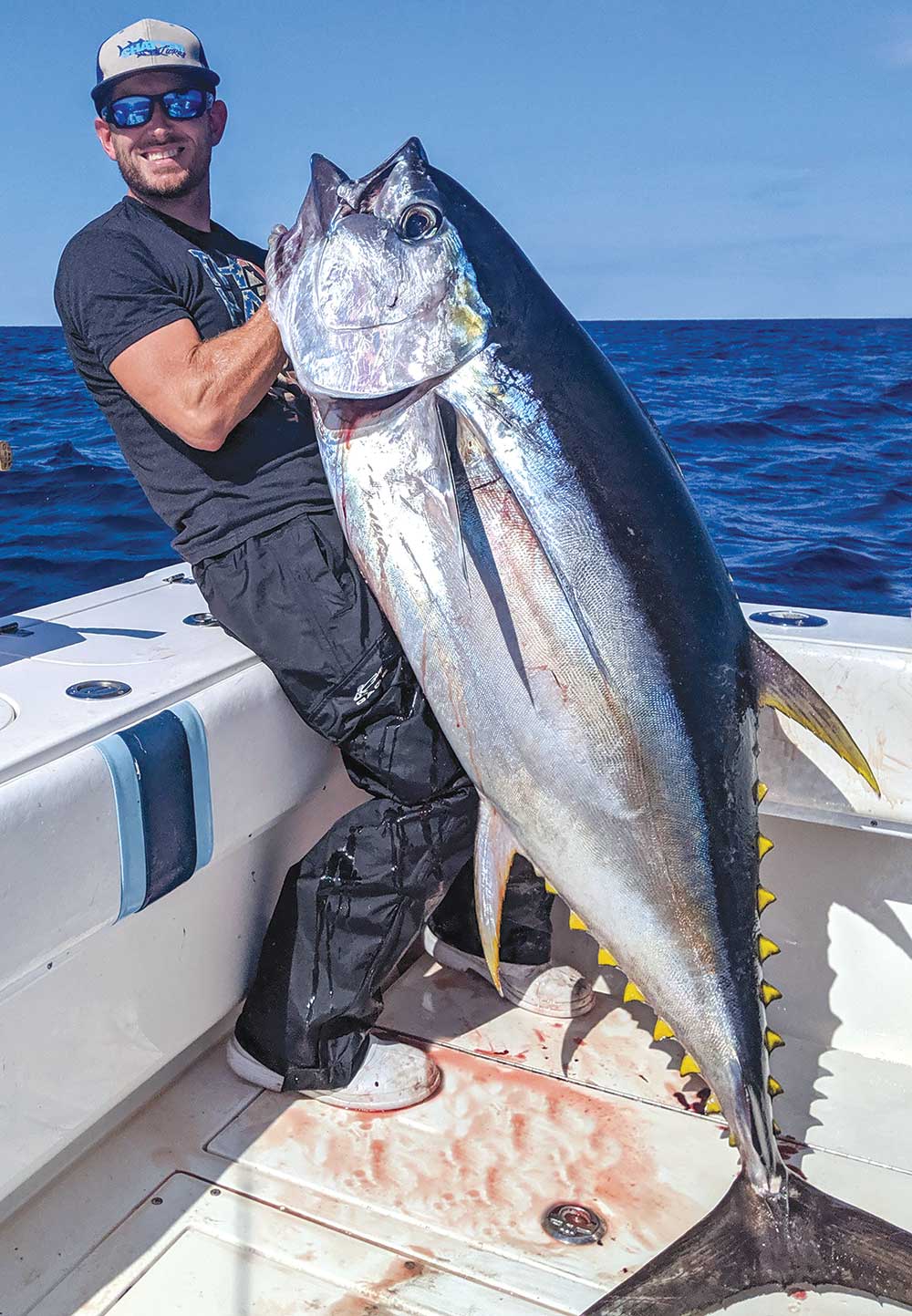
The most popular colors have been sand eel (dark brown streak), purple/black, rainbow, and green. There are two standard sizes; 19- or 36-inch bars, with 6- or 9-inch lures. The lures are normally bulb squids with floats or resin head machines. The heavier machine heads work better in adverse conditions when wind and seas are sporty. The standard mainline is 200- to 250-pound test with customizable heavy-duty stingers available for bigeye and larger bluefin. Using a 100- to 200-pound top-shot in front of the bar is highly recommended. Most of this line is out of the water when trolling and the bird action and splashing will help camouflage the portion that’s not.
Just keep in mind that not all bars are created equal, and you get what you pay for. There are several manufacturers in the Northeast and Mid-Atlantic offering these bars. The two dominant players are Chatter Lures from New York and Sterling Tackle out of New Jersey. The first appearance on the midrange and offshore grounds came as “wide trackers” which is the term coined by Sterling Tackle (www.sterlingtackle.com). Chatter later introduced a multi-directional self-righting version known as side trackers (www.chatterlures.com). Both work extremely well at raising and catching fish. It’s more of a personal preference regarding price versus features when selecting them.
What separates these manufacturers from the rest is the quality of materials, and vibrant colors of the birds and lures they both employ. There are many cheaper versions on the market that are basically disposable. They will attract the strike, but you will either loose the fish during the fight or the bar will get destroyed. Spend the extra money and stick with these two manufacturers. Back at the scales you will be glad you did.
Remember that every lure in any position must be inspected before deploying it in a trolling spread, and special attention must be paid to these bars. They are so good that they will get beat up, so inspecting and re-rigging them is a must. They tend to spin when pulled underwater fighting a fish. This can pull the side wings in, bending the bar and compromising the leaders. You should have extra stinger baits and if possible spare bars. When re-rigging, make sure you do it correctly. If you’re not sure, call the manufacturer or bring it in and have it done professionally.
If you are doing it yourself, it is a good idea to have a second bar handy as a template. Manufacturers have spent countless test hours getting the bars to track and present correctly. Do not modify their work; you will change the performance of the bar. Changing the location of the birds, wings, and squids can cause the bar to dig in and not achieve optimal performance. Balance is critical too; everything needs to be perfectly symmetrical and in harmony.
If you are not trolling these yet, do yourself a favor and give them a try. They are game-changers!
